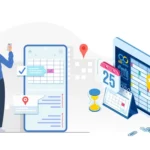Employee time tracking may seem like a straightforward task—employees record their hours on a timesheet or use a time clock, turning in their time cards at the end of the week or month. However, this seemingly simple process can present numerous challenges.
Accurately tracking employee hours is a critical responsibility for any business. It provides insights into the use of time, labor costs, and areas for productivity enhancement.
Whether you run a large corporation or a small business, streamlining time tracking for both employees and managers is crucial. There are many benefits of time tracking, such as improving profit margins, precise project bidding, and overall success.
Traditionally, employers have heavily depended on manual timecards for monitoring employee work hours. This involves employees either using a clock-in clock-out system or manually recording and reporting their working hours. The manual nature of this process has a higher margin of errors, miscalculations, and reliance on estimates.
In a 2018 survey, 44% of business owners admitted to struggling with timesheet errors, with a staggering 92% attributing these errors to the users themselves. The primary issues reported included employees forgetting to log their time, recording time inaccurately, or attributing it to the wrong job.
Fortunately, business owners can now transition from traditional manual time tracking methods to more efficient solutions. These include time tracking software and apps. The shift brings numerous benefits, simplifying timekeeping and significantly enhancing the accuracy of labor cost calculations.
Benefits of Employee Time Tracking Software
Enhanced Field Force Productivity: Time tracking software provides field employees with a clear overview of their working hours, improving focus and productivity. It boosts confidence among high-performing staff and holds others accountable, addressing issues promptly.
Precise Work Hours Tracking: Real-time reporting in time tracking apps offers accurate project status updates, identifies delays, and allows quick resolution of errors or issues. It eliminates the inaccuracies of manual time logs, ensuring a precise record of tasks and meeting durations.
Instantaneous Work Records: Employee time tracking apps records field team activities, offering valuable data analytics. Automated data reports provide detailed information instantly, facilitating transparent communication with clients and supporting discussions on task duration.
Cost Reduction and Savings: Time tracking apps save money by streamlining management efforts and improving employee efficiency. They identify less profitable tasks, allowing businesses to optimize resource usage and replace unprofitable activities with more lucrative ones.
Enhanced Transparency and Accountability: Employee time tracking app fosters transparency for field employees, aiding in better planning and workload management. Managers can prioritize tasks based on real-time information, and employees become more accountable, knowing their work records are under review, resulting in increased productivity.
While time tracking offers a multitude of benefits, it also requires careful consideration to avoid common mistakes. These errors can include insufficient detailing of employee work hours, underutilization of the software’s features, etc. among others.
By leveraging time tracking software effectively, businesses in field services can not only streamline their operations but also enhance transparency, accuracy, and overall efficiency in managing their workforce.
Avoid These Common Time Tracking Mistakes
Continuing with the traditional employee time tracking methods can feel convenient, but making small improvements can lead to substantial savings. Adopting a new way of time tracking is a challenge. However, with the right employee time tracking software, you can streamline your time tracking process significantly.
By steering clear of these common mistakes, you can enhance your timekeeping system’s efficiency:
Lack of Detail in Employee Work Hours
While simplicity in timecards is essential, it’s crucial not to oversimplify data. Beyond basic clock-ins and outs, federal law mandates tracking breaks, lunches, regular work hours, and overtime. Efficient employee time tracking software allows for detailed documentation, enabling smarter decision-making about labor management, project allocation, and resource utilization.
Underutilizing Time Tracking App’s Features
The best time tracking app for your business should provide you with multiple benefits. Even without technical expertise, time tracking solutions offer user-friendly features to enhance efficiency. Real-time tracking, location-based clock-ins, geofencing for job sites, and alerts for overtime or location changes are just a few examples. Leveraging these features ensures a more effective use of time tracking software.
Neglecting Integration of Payroll and Compensation
These aspects are interconnected, and combining them into one solution can save time and enhance compliance with labor laws. The employee time tracking software you opt for must provide an end-to-end solution. Therefore, it must integrate with payroll systems, address worker’s compensation, and perform accurate time tracking. This integration streamlines processes, ensuring seamless paydays, coverage in case of accidents, and consolidated HR functions.
Conclusion
Enhancing employee time tracking doesn’t require significant effort; the benefits are substantial. Taking the time to explore an end-to-end time tracking software can help simplify time tracking for your employees, leading to increased efficiency, time savings, and overall improvement for your company.
An employee time tracking app that balances the advantages of time tracking and addresses potential challenges enables field businesses to navigate workforce management complexities successfully.
Adopting time tracking is imperative for field businesses in the contemporary landscape. It catalyzes enhanced productivity and accurate labor cost management. While transitioning to employee time tracking software is a crucial step, it is equally vital for businesses to be aware of common mistakes that could undermine its effectiveness. Recognizing and avoiding these pitfalls, such as insufficient detailing of work hours and underutilization of software features, is pivotal.
